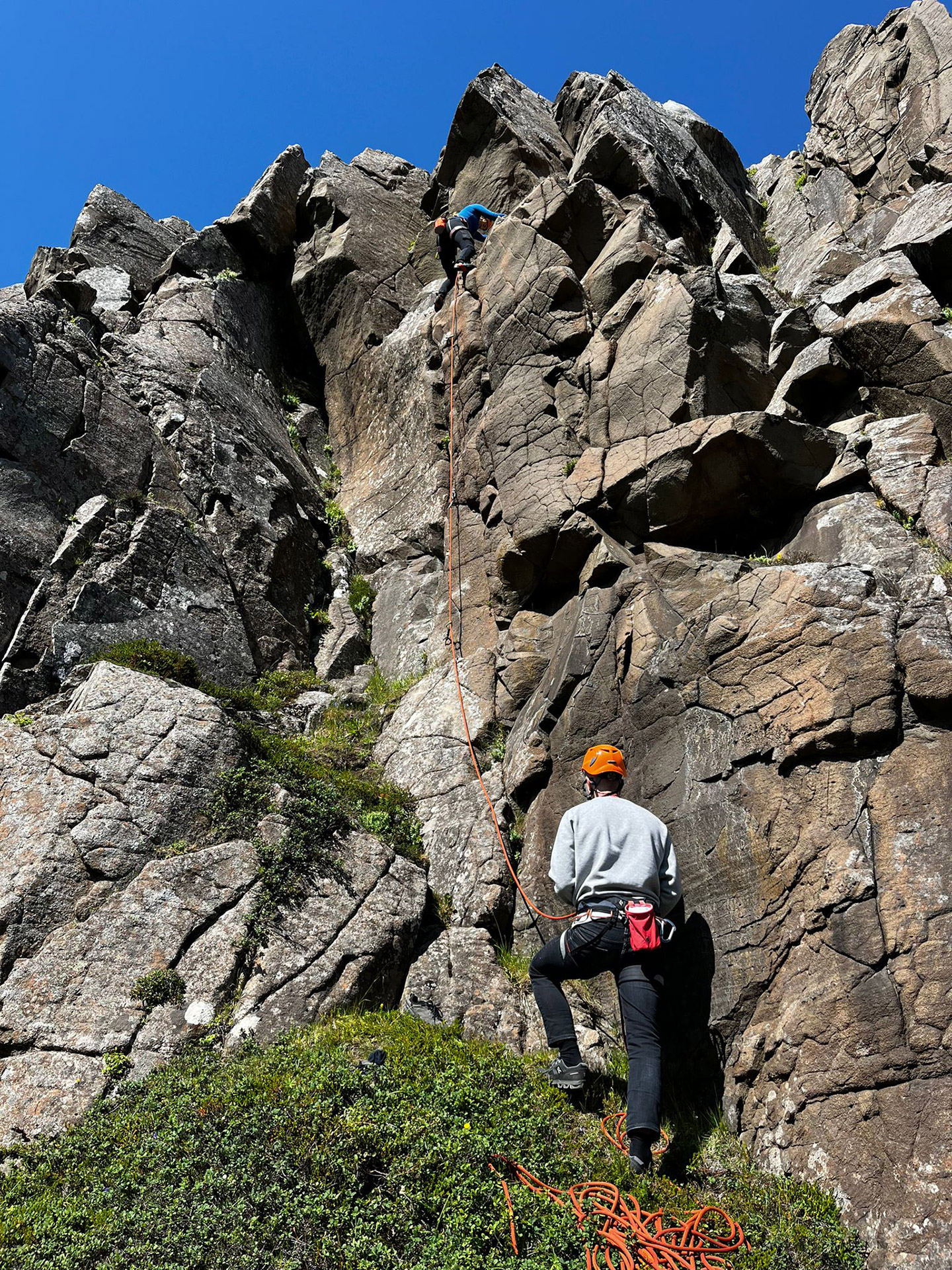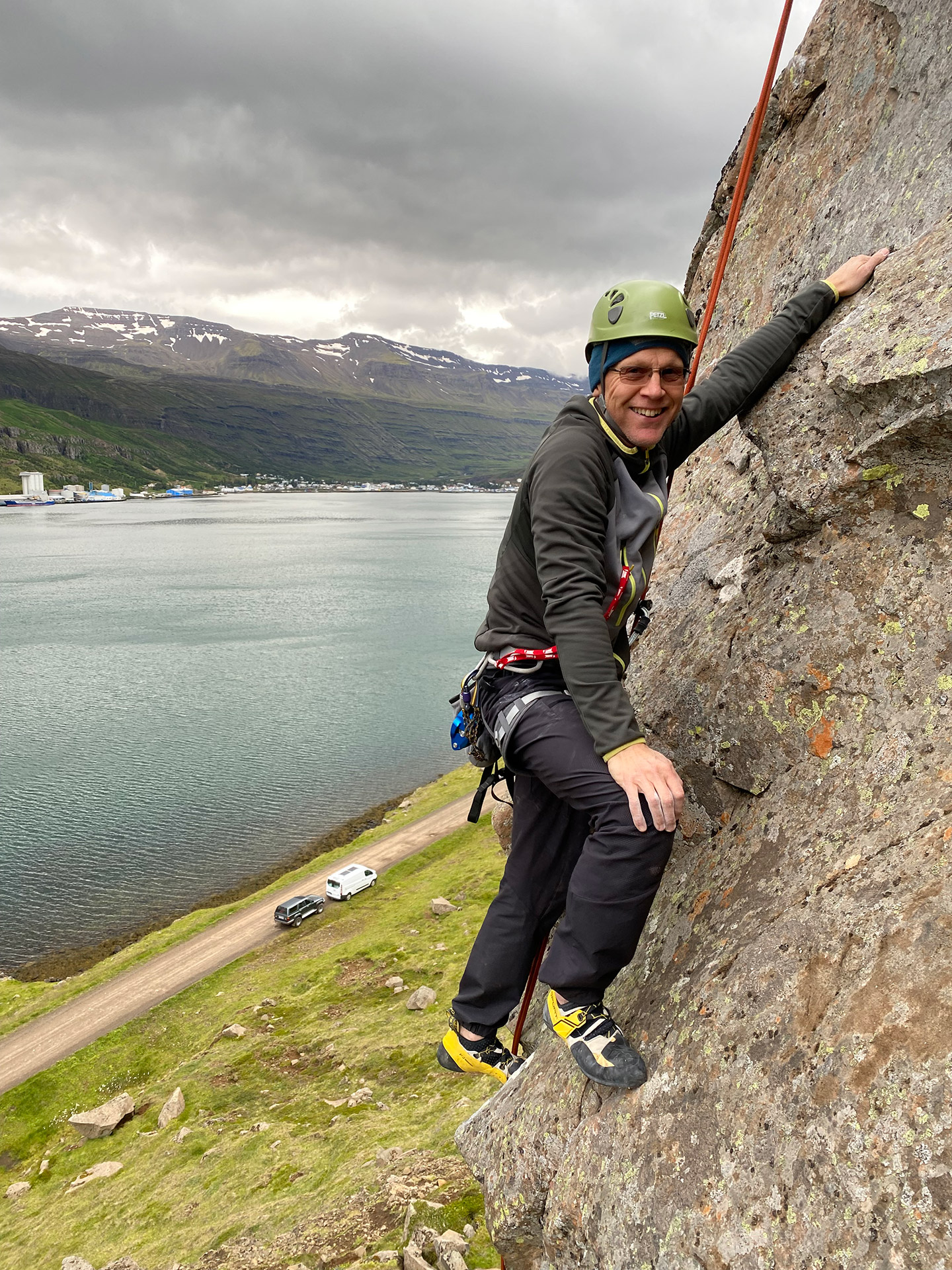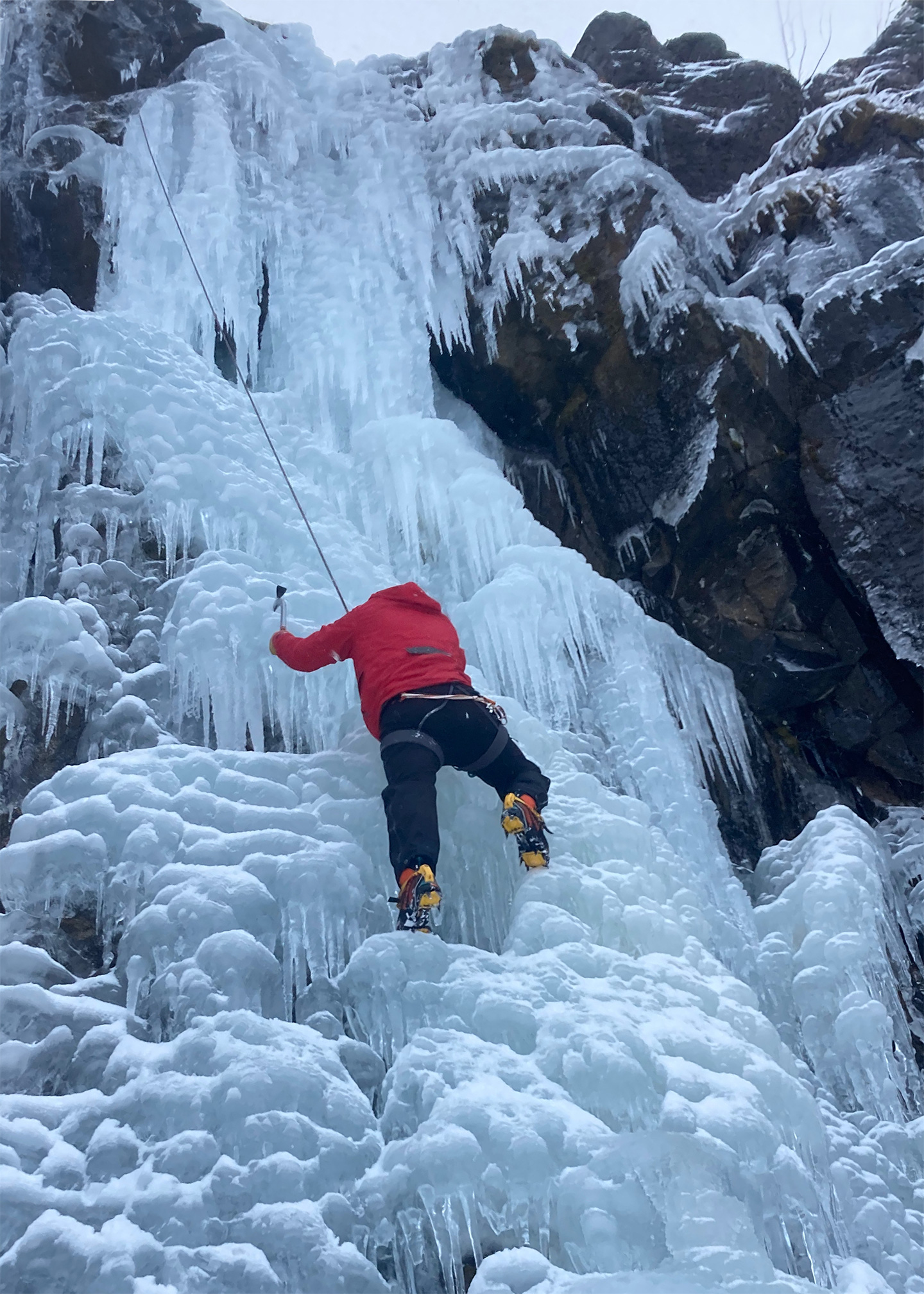Rock climbing in Austurland
Rock climbing in East Iceland is an off-the-beaten-path adventure that offers climbers a chance to engage with some of the country’s landscapes. Austurland is characterized by fjords, mountains and fishing villages, which combine to provide a unique backdrop for rock climbing enthusiasts.
The climbing in East Iceland is less frequented than the more popular climbing spots in South Iceland or near Reykjavík, which means climbers often have the crags to themselves, allowing for a more intimate connection with nature.
The area is known for its basalt formations, which are ideal for climbing. The rock here is typically solid and provides good friction, making for an enjoyable climbing experience.
If you’re new to rock climbing, scroll down to read an overview of Iceland’s climbing scene.
 Arnarklettar, Seyðisfjörður. Photo from Jafet's collection
Arnarklettar, Seyðisfjörður. Photo from Jafet's collection
Sport climbing in Seyðisfjörður
Most, if not all, outdoor sport climbing areas are developed by enthusiastic individuals – and that’s what’s been happening in the beautiful Austurland town of Seyðisfjörður.
Over the past couple of years, two friends, Einar Sveinn Jónsson and Jafet Bjarkar Björnsson, have been developing routes. These guys are passionate about putting rock climbing on the Austurland map.
Thanks to their efforts, there are 24 sport climbing routes in Seyðisfjörður. Jafet has received funding for bolting more routes – so the plan is to develop 28 new routes in summer 2024, making Seyðisfjörður a flourishing new destination for climbers.
Most of the sport climbing route development is happening is Arnarklettur (‘Eagle Cliffs’), in the beautiful Vestdalur(‘West Valley’) area. The area is about 3km (2 miles) from town; the cliffs are easily visible from the road.
 Einar taking a short break to smile for the camera. Photo Jafet Bjarkar.
Einar taking a short break to smile for the camera. Photo Jafet Bjarkar.
A few tips
There are some real positives to heading east to Seyðisfjörður for a climbing adventure. One is the proximity of the climbing area to the excellent services of the town. Another is the great view from the crags over the fjord – you may even get lucky and see whales.
Here are some tips for successful sport climbing in the area, and some essential safety advice:
- On Iceland’s biggest climbing website you’ll find is/crag/seydisfjordur dedicated to Seyðisfjörður.
- Arnarklettur, the local crag, is quite beginner-friendly but there are also some more difficult routes.
- The rock quality is good but it’s recommended to wear a helmet as the crag is new.
- The crag is approachable – the cliffs are just a 2-minute walk from the road.
- The routes are 7 to 18 meters high (23 to 59ft).
- They range in grade from 5b to 7b (Note for novices: The harder a climb, the higher the number.)
- It’s vital to learn proper safety technique for safe sport climbing. It’s recommended that beginners climb with someone with experience.
Summer in Seyðisfjörður
Color and creativity abound in Seyðisfjörður, a village filled with bright cottages and artist studios. Recently it has become famous for its photogenic Rainbow Street, which ends out front of the pretty blue town church. It’s not hard to see reasons behind the town’s popularity with tourists, as nature combines with local life to make visitors reach for their hiking boots and camera.
The town community numbers only around 700 but it impressively manages a thriving arts scene that includes summer and winter art-themed festivals, artist residencies, and even art installations high in the hills.
 Hikers admiring Gufufoss, one of Fjarðará waterfalls. Photo: Ingvi Örn.
Hikers admiring Gufufoss, one of Fjarðará waterfalls. Photo: Ingvi Örn.
Walking and hiking trails can take you to Tvísöngur (a mountainside sound sculpture), alongside the Fjarðará river or the edge of the fjord, or high into the surrounding hills and valleys to encounter wild waterfalls and impressive panoramas. Summertime activities range from stellar hikes to scenic boat trips, and exciting new options for jeep or e-bike tours. There’s even a nine-hole golf course!
Services in Seyðisfjörður are excellent, with an abundance of high-quality places to stay and eat across all budgets. There’s a popular campground, plenty of guesthouses, hostels and hotels, and apartments for rent. Your taste buds will be happy too – some of Iceland’s finest sushi puts all that fresh fjord fish to good use, and there are great spots to sample local flavors or simply refuel for more climbing.
We look forward to seeing you on the crags in Seyðisfjörður!

Overview of the town of Seyðisfjörður from the climbing area in Vestdalur. Photo: EInar Sveinn.
An introduction to rock climbing in Iceland
Rock climbing in Iceland presents a unique and exhilarating experience, combining the thrill of the climb with the country’s breathtaking landscapes.
Iceland is justly famous for its rugged terrain, and that same terrain offers climbers a range of options, from beginner-friendly crags to challenging ice climbs.
The geology
Iceland’s geological diversity plays a pivotal role in rock climbing adventures here. The country’s volcanic origins contribute to an abundance of basalt and rhyolite formations, providing a variety of textures and challenges for climbers.
Basalt, known for its stability and grip, is commonly found in areas like Hnappavellir, Iceland’s largest and most popular climbing area. Hnappavellir is on the country’s south coast, near Skaftafell in Vatnajökull National Park.
The climbing season
Iceland’s rock climbing season typically runs from late spring to early autumn, with the best conditions usually found in June and July. During these months, the island experiences near 24-hour daylight, giving climbers ample time to tackle longer routes or enjoy multiple climbs in a day. Still, weather in Iceland can be unpredictable, and it’s essential to be prepared for sudden changes in conditions.
 Ice climbing in one of the waterfalls on the way to Tvísöngur sound sculpture on the south side of the fjord. Photo: Hilmar Guðjóns.
Ice climbing in one of the waterfalls on the way to Tvísöngur sound sculpture on the south side of the fjord. Photo: Hilmar Guðjóns.
You can’t discuss rock climbing in Iceland without mentioning ice climbing. Winter transforms the landscape, offering spectacular ice climbing opportunities. Frozen waterfalls and icy gorges present a different kind of challenge. Popular ice climbing spots include the waterfalls in Vatnajökull National Park, home to Europe’s largest glacier.
Safety
Safety is paramount in Icelandic climbing. The remoteness of many climbing areas means that help can be hours away. It’s crucial for climbers to be well prepared, have the right gear, and, ideally, climb with someone knowledgeable about the area.
Community
Local climbing clubs and guides can provide valuable information and support, especially for those new to the country’s climbing scene.
The climbing community in Iceland, though small, is welcoming and enthusiastic. There are a handful of climbing gyms in Reykjavík where climbers can meet locals, get tips, and maybe even find a climbing partner. Events and competitions are also held, fostering a sense of community and camaraderie.
The Climbing Association of Reykjavík is known as Klifurhúsið.
Iceland’s biggest climbing website is klifur.is, and here you can find plenty of useful information. The goal of the site is to collect all the information available about climbing in Iceland in one place and make it accessible to everyone. Klifur.is is also a place to read news, and view photos and videos produced by the climbing community.
Types of rock climbing
If you’re new to the sport, it’s useful to know the main types of outdoor climbing:
Bouldering is climbing without rope at heights that typically allow you to safely jump down to the ground (say, around 2 to 5 meters or 6 to 16 ft). Bouldering outdoors means that you need to make sure that the landing area is safe. This is typically done using so-called crash-pads.
Sport climbing involves climbing routes that are equipped with permanently fixed protection such as pre-installed bolts and anchors. It requires an experienced and reliable partner, and minimum gear such as climbing shoes, harness, belay device, rope and a number of quickdraws to clip into the pre-installed protection. A helmet is recommended. Routes are usually 5 to 30 meters or 16 to 98 ft (though they can be a lot higher).
Traditional climbing involves climbing routes in which removable protection against falls is placed by the climber while they climb. Trad climbing requires the same basic equipment as sport climbing, plus the protective gear such as cams and nuts.
Ice climbing is a style of roped and protected climbing of features such as icefalls, frozen waterfalls, and cliffs and rock slabs covered with ice refrozen from flows of water.

